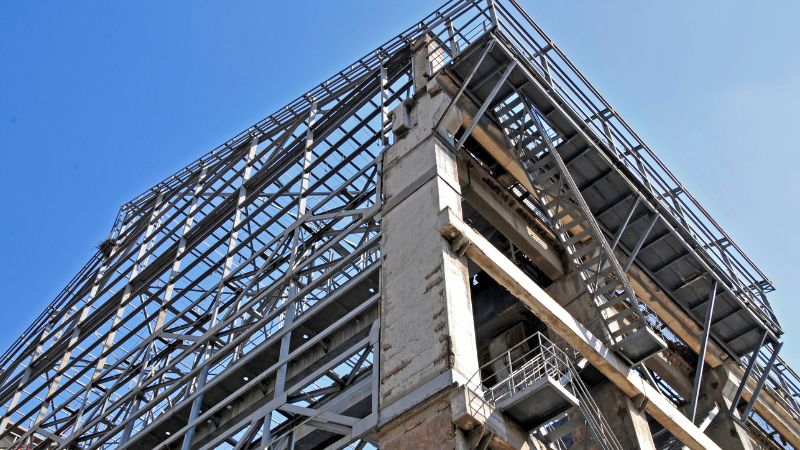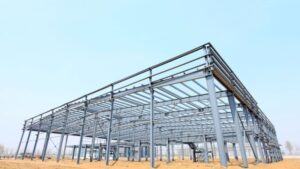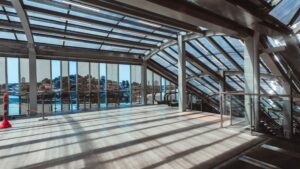Strength And Durability
Steel structure buildings are valued for their solid frame, strong resistance to outside forces, and low need for repairs. These qualities make steel a trusted material for many types of projects, including large-scale infrastructure.
High Load-Bearing Capacity
Steel can handle a lot of weight without bending or breaking. You can build tall skyscrapers, wide warehouses, or large stadiums thanks to steel’s ability to support heavy loads.
Your building can house heavy machines, large storage racks, or several floors without the risk of the structure weakening. Because the metal is so strong, steel structures can often have thinner walls or beams, which leaves more usable space inside.
Another benefit is how easy it is to adjust. You can add more floors or make changes to your building later, without worrying so much about the weight limits. This flexibility can be useful if your business needs change in the future.
Resistance To Natural Disasters
Steel frame buildings are built to withstand high winds, heavy snow, and even earthquakes better than many other materials. Strong steel connections and solid joints help prevent shaking or collapse during storms.
In regions where earthquakes happen, steel’s flexibility lets the building move slightly without breaking. Steel does not rot, warp, or get eaten by pests, so your building is less likely to get damaged over time from moisture or insects.
Many fire codes rank steel as a safer option because steel does not burn or feed flames. This can lower the risk of severe damage during fires and can help protect people inside the building.
Long Lifespan
Buildings made from steel often last for decades with only a small amount of maintenance. Steel does not rust easily because it can be coated or treated to resist water and chemicals.
You won’t need to replace parts of the frame often, and routine care like repainting is usually enough to keep everything in good shape. This means you spend less on upkeep compared to wood or concrete, which can crack, rot, or shift.
Steel stands up to daily use and natural wear, keeping its strength and shape year after year. When it is time to change or recycle the building, steel can be reused rather than thrown away, making it a smart long-term choice.
Minimal Deformation Under Stress
When heavy loads or strong forces hit a steel structure, it is not likely to bend, twist, or sag. Steel’s stiffness and strong welds keep the frame steady, even under changing pressures.
This quality helps your building keep its original shape. There is less risk of doors or windows sticking, and floors do not become uneven over time. It also means fewer repairs, since weaker materials can shift or deform and cause damage.
If your area faces high traffic, frequent use, or challenging weather, steel is well-known for keeping its form and staying reliable. Stability under stress helps give you peace of mind about your investment.
Speed Of Construction
Prefabrication Advantages
Steel components are often made in factories before they ever reach your building site. This process is called prefabrication. Skilled workers use machines to cut, drill, and weld steel members to exact sizes. Because of this, parts fit together well and there are fewer surprises on the jobsite.
Prefabrication means you can avoid weather delays that often slow down construction with wood or concrete. Your project keeps moving forward even when it rains or snows because most of the work is protected indoors at the factory. When it’s time to start assembly, all the pieces are ready to go.
Steel parts can also be delivered as needed using a just-in-time schedule. This keeps your site less crowded and easier to manage. Projects using prefabricated steel often move from ground-breaking to completion in a much shorter time than traditional methods.
Reduced On-Site Labor Requirements
With steel structures, you need far fewer workers and less time on your building site. Because so much work is done ahead of time in a factory, your crew mainly focuses on putting pieces together instead of building them from scratch.
Pre-made steel beams and frames are lighter and easier to handle with cranes or lifts. This saves energy and reduces heavy, manual labor. Training for assembly is also simpler and often safer, lowering the risk of jobsite injuries.
Once the steel frame is up, you can quickly add walls, floors, and roofs. This step-by-step process means other trades, like electricians and plumbers, can start their work sooner, speeding up your whole build. By using fewer workers for less time, you save money on labor costs and finish your project quickly.
Design Flexibility
Large Open Spaces
With steel, you can design buildings that have wide areas without many columns or walls in the way. Steel beams and frames can support more weight over longer distances.
This lets you enjoy open layouts in places like gyms, offices, and stores. It’s easier to fit in larger rooms or change how you use the space.
Many people pick steel because it makes interiors feel bigger and brighter. Natural light can fill the area since there aren’t as many barriers. If you want big, open rooms, steel makes that possible.
Adaptability To Complex Architectures
Steel is strong and flexible, so you can work with creative or unusual designs. You aren’t limited to basic shapes like squares or rectangles.
You can have arches, curves, or odd angles in your building. Steel can be molded and joined in many ways, so your plans don’t need to be simple.
This helps you match the look you want and use your space in special ways. If your project has strict requirements or a unique style, steel offers you more freedom.
Easy Future Expansions
If you want to add on to your building later, steel makes the process easier. You can extend or change the layout with less time and effort.
The frame is built to handle changes, so it’s not as hard to add another floor or new rooms. This is helpful for growing businesses or changing needs.
Sustainability And Environmental Benefits
Recyclability Of Steel
Steel is 100% recyclable and can be used over and over without losing its strength. This means when your building reaches the end of its life, the steel can be recycled into new products instead of ending up in a landfill.
Most steel used today contains a high percentage of recycled content from old cars, appliances, and even other buildings. This reduces the demand for raw materials and saves natural resources, like iron ore and coal, that would otherwise need to be mined.
Because steel recycling is widely available, you’ll find it easier to responsibly handle construction leftovers. Choosing steel goes a long way toward keeping your project environmentally friendly.
Efficient Material Usage
Steel buildings are designed to use just the right amount of material for each part of the structure. You won’t need extra beams or unnecessary supports, which helps cut down on waste.
Prefabrication, where steel parts are made in a factory, lets you order the exact pieces you need. This helps keep scrap to a minimum and reduces mistakes on the construction site.
Because every piece is precisely made, the whole building process is cleaner and faster. You save time and avoid the clutter of unused materials, all while using your resources more wisely.
Lower Environmental Impact
Steel buildings are tough, so they last a long time before needing major repairs or replacement. This long lifespan means fewer materials are used over the years. Steel’s resistance to mold, mildew, and rot also keeps your building safer with less maintenance.
You can achieve good energy efficiency by adding insulation and thoughtful design choices, which helps save on heating and cooling costs. Strong steel frames mean you can use larger windows, letting in more natural light and cutting the need for electric lights.
By needing less upkeep and helping you save energy, steel structures create a smaller environmental footprint compared to traditional building materials.


